Kitchenaid Kcmc155jwh, Kcmc155jbt, Kcmc155jbl, Kcmc155jss Owner's Manual
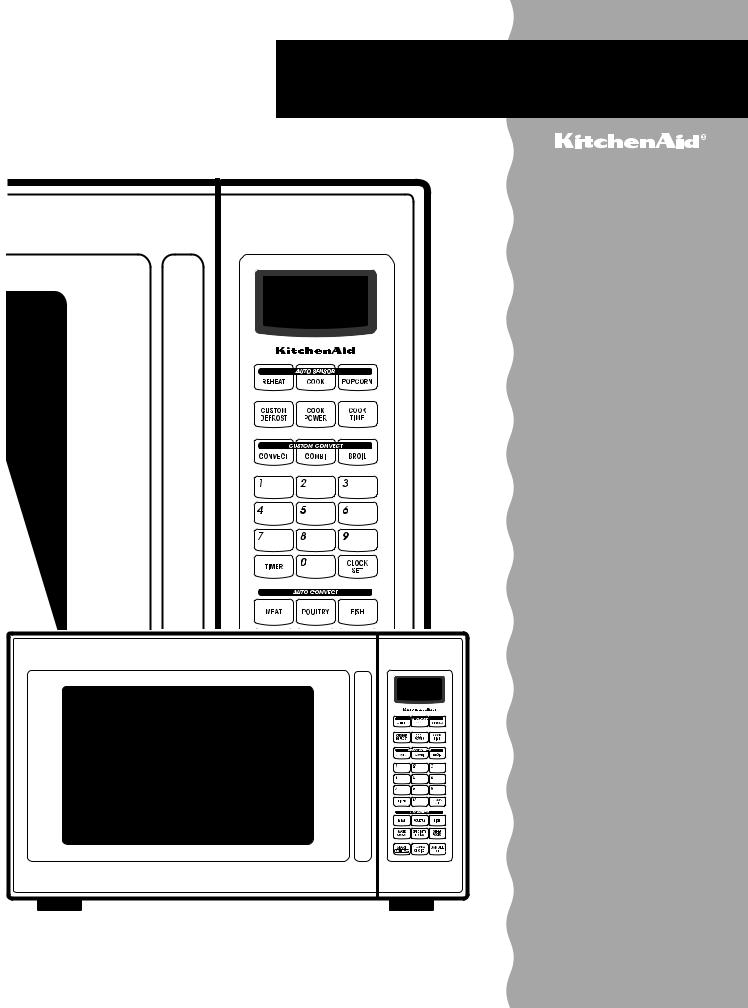
Model
KCMC155J
U s e & C a r e G u i d e
Microwave Oven
A Note to You ............................................ |
2 |
Microwave Oven Safety .......................... |
3 |
Installation Instructions............................ |
5 |
Getting to Know Your Microwave Oven..7 |
|
How your microwave oven works........ |
7 |
How convection cooking works .......... |
7 |
How combination cooking works ........ |
7 |
Microwave cooking tips ........................ |
7 |
Radio interference ................................ |
9 |
For the best cooking results ................ |
9 |
Testing your microwave oven .............. |
9 |
Oven utensils guide .............................. |
9 |
Testing your dinnerware |
|
or cookware ............................................ |
10 |
Operating tips ...................................... |
10 |
Electrical connection .......................... |
10 |
Microwave oven features.................... |
11 |
Control panel features ........................ |
12 |
Using PERSONAL CHOICE ................ |
13 |
Built-in kits............................................ |
13 |
Setting the clock.................................. |
14 |
Using the minute timer........................ |
14 |
Using Your Microwave Oven ................ |
15 |
Cooking at high cook power .............. |
15 |
Cooking at different cook powers...... |
15 |
Cooking with more than one |
|
cook cycle................................................ |
16 |
Using CUSTOM DEFROST ................ |
17 |
Using manual defrost .......................... |
17 |
Defrosting tips...................................... |
17 |
Using EASY START.............................. |
18 |
Using Warm Hold ................................ |
18 |
Auto Sensor Cooking ............................ |
19 |
Using AUTO SENSOR COOK ............ |
19 |
Sensor cooking chart .......................... |
19 |
Using AUTO SENSOR REHEAT.......... |
20 |
Sensor reheating chart........................ |
20 |
Using AUTO SENSOR POPCORN .... |
20 |
Sensor popcorn chart ........................ |
20 |
Convection and Combination Cooking..21 |
|
Custom convection cooking .............. |
21 |
Helpful hints for convection cooking..21 |
|
Using the drip pan .............................. |
21 |
Raising (proofing) bread...................... |
22 |
Custom combination cooking ............ |
22 |
Helpful hints for combination |
|
cooking ................................................ |
22 |
Custom broil cooking .......................... |
22 |
Helpful hints for broiling...................... |
23 |
Auto convection cooking .................... |
23 |
Caring for Your Microwave Oven ........ |
26 |
Questions and Answers ........................ |
27 |
Troubleshooting ...................................... |
28 |
Requesting Assistance or Service........ |
29 |
Warranty .................................................. |
30 |
1•800•422•1230
Call our Customer Interaction Center with questions
or comments.
3828W5A1492/8172191 |
www.kitchenaid.com |

A Note to You
Thank you for buying a KITCHENAID® appliance!
KitchenAid designs the best tools for the most important room in your house. To ensure that you enjoy many years of trouble-free operation, we developed this Use and Care Guide. It contains valuable information concerning how to operate and maintain your new appliance properly. Please read it carefully.
Also, please complete and mail the enclosed Product Registration Card.
For assistance or service
Call the Customer Interaction Center toll free ........................................................................ |
1-800-422-1230 |
If you need assistance or service, first see the “Troubleshooting” section of this book. After checking “Troubleshooting,” additional help can be found by checking the “Requesting Assistance or Service” section, or by calling the telephone number above.
When calling, you will need to know your appliance’s complete model number and serial number. You can find this information on the model and serial number label/plate (see diagram in the “Getting to Know Your Microwave Oven” section.)
Keep this book and the sales slip together in a safe place for future reference. You must provide proof of purchase or installation date for in-warranty service.
Model Number _____________________________ |
Builder/Dealer Name _______________________ |
Serial Number _____________________________ |
Address __________________________________ |
Date Installed _____________________________ |
Phone ____________________________________ |
2
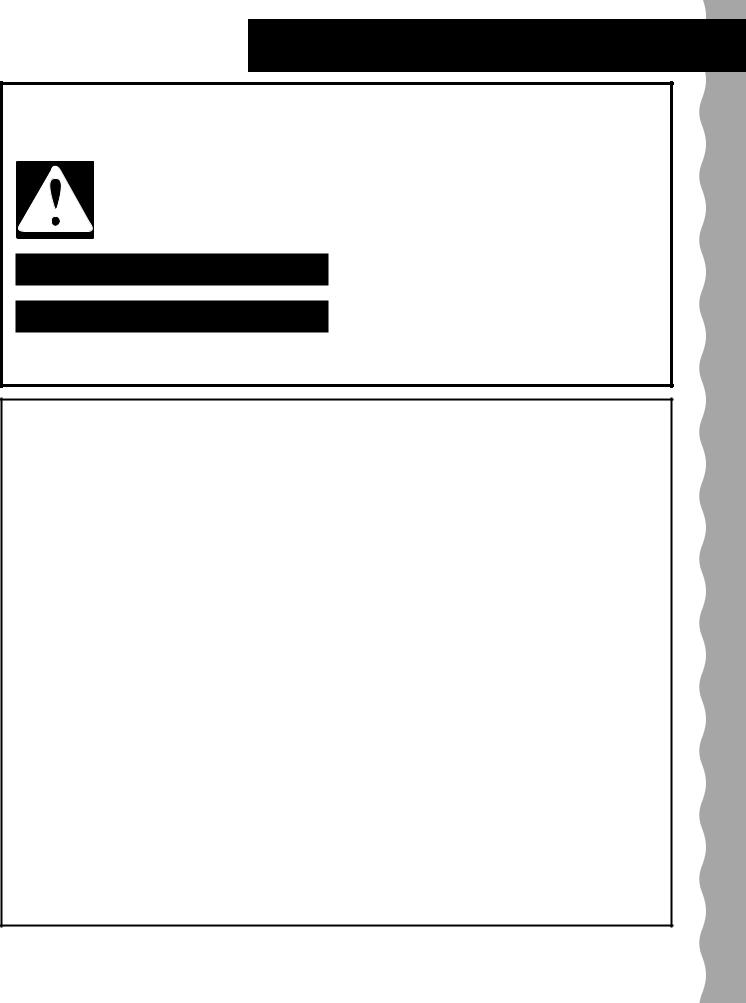
Microwave Oven Safety
Your safety and the safety of others are very important.
We have provided many important safety messages in this manual and on your appliance. Always read and obey all safety messages.
This is the safety alert symbol.
This symbol alerts you to potential hazards that can kill or hurt you and others.
All safety messages will follow the safety alert symbol and either the word “DANGER” or “WARNING.” These words mean:
wDANGER
wWARNING
You can be killed or seriously injured if you don't immediately follow instructions.
You can be killed or seriously injured if you don't follow instructions.
All safety messages will tell you what the potential hazard is, tell you how to reduce the chance of injury, and tell you what can happen if the instructions are not followed.
IMPORTANT SAFETY INSTRUCTIONS
When using electrical appliances basic safety precautions should be followed, including the following:
WARNING: To reduce the risk of burns, electric shock, fire, injury to persons or exposure to excessive microwave energy:
•Read all instructions before using the microwave oven.
•Read and follow the specific “PRECAUTIONS TO AVOID POSSIBLE EXPOSURE TO EXCESSIVE MICROWAVE ENERGY” found in this section.
•The microwave oven must be grounded. Connect only to properly grounded outlet. See “GROUNDING INSTRUCTIONS” found in the “Installation Instructions” section.
•Install or locate the microwave oven only in accordance with the installation instructions.
•Some products such as whole eggs and sealed containers – for example, closed glass jars – may explode and should not be heated in the microwave oven.
•Use the microwave oven only for its intended use as described in this manual. Do not use corrosive chemicals or vapors in the microwave oven. This type of oven is specifically designed to heat, cook, or dry food. It is not designed for industrial or laboratory use.
•As with any appliance, close supervision is necessary when used by children.
•Do not operate the microwave oven if it has a damaged cord or plug, if it is not working properly, or if it has been damaged or dropped.
•The microwave oven should be serviced only by qualified service personnel. Call an authorized service company for examination, repair or adjustment.
•Do not cover or block any openings on the microwave oven.
•Do not store the microwave oven outdoors. Do not use the microwave oven near water – for example, near a kitchen sink, in a wet basement, or near a swimming pool, and the like.
•Do not immerse cord or plug in water.
•Keep cord away from heated surfaces.
•Do not let cord hang over edge of table or counter.
•See door surface cleaning instructions in the “Caring for Your Microwave Oven” section.
SAVE THESE INSTRUCTIONS
continued on next page
3
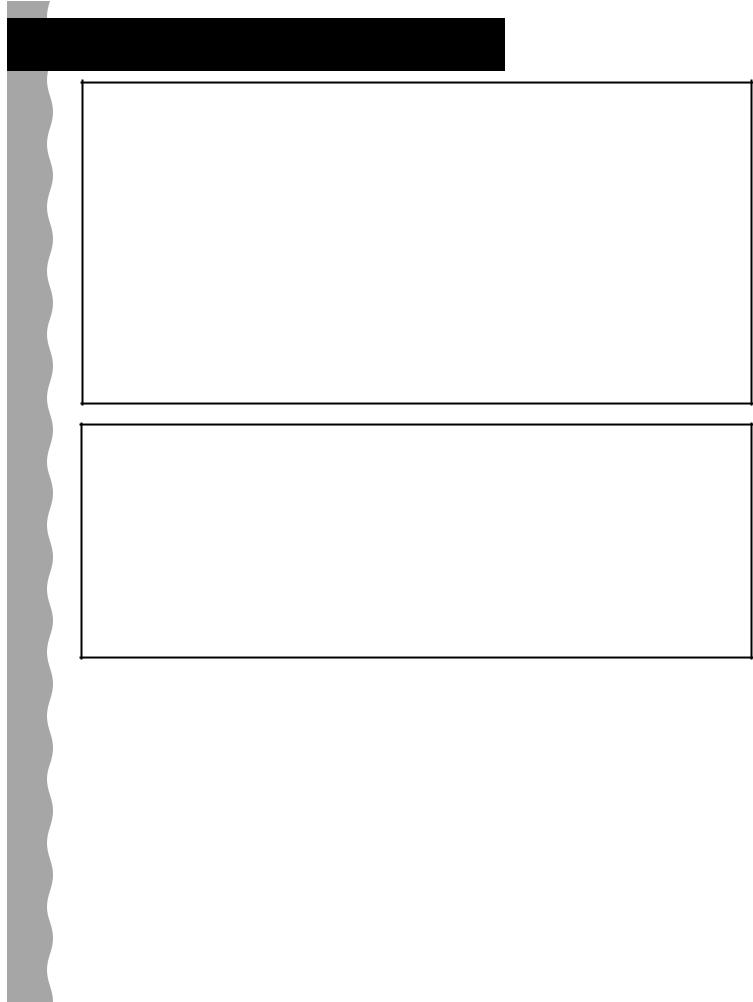
Microwave Oven Safety
IMPORTANT SAFETY INSTRUCTIONS
•Do not operate any heating or cooking appliance beneath the microwave oven.
•Do not mount microwave oven over or near any portion of a heating or cooking appliance.
•Do not mount over a sink.
•Do not store anything directly on top of the microwave oven surface when the microwave oven is in operation.
•To reduce the risk of fire in the oven cavity:
–Do not overcook food. Carefully attend the microwave oven if paper, plastic, or other combustible materials are placed inside the oven to facilitate cooking.
–Remove wire twist-ties from paper or plastic bags before placing bag in oven.
–If materials inside the oven should ignite, keep oven door closed, turn oven off, and disconnect the power cord, or shut off power at the fuse or circuit breaker panel.
–Do not use the cavity for storage purposes. Do not leave paper products, cooking utensils, or food in the cavity when not in use.
SAVE THESE INSTRUCTIONS
PRECAUTIONS TO AVOID POSSIBLE EXPOSURE TO EXCESSIVE MICROWAVE ENERGY
(a)Do not attempt to operate this oven with the door open since open-door operation can result in harmful exposure to microwave energy. It is important not to defeat or tamper with the safety interlocks.
(b)Do not place any object between the oven front face and the door or allow soil or cleaner residue to accumulate on sealing surfaces.
(c)Do not operate the oven if it is damaged. It is particularly important that the oven door close properly and that there is no damage to the:
(1)door (bent),
(2)hinges and latches (broken or loosened),
(3)door seals and sealing surfaces.
(d)The oven should not be adjusted or repaired by anyone except properly qualified service personnel.
4
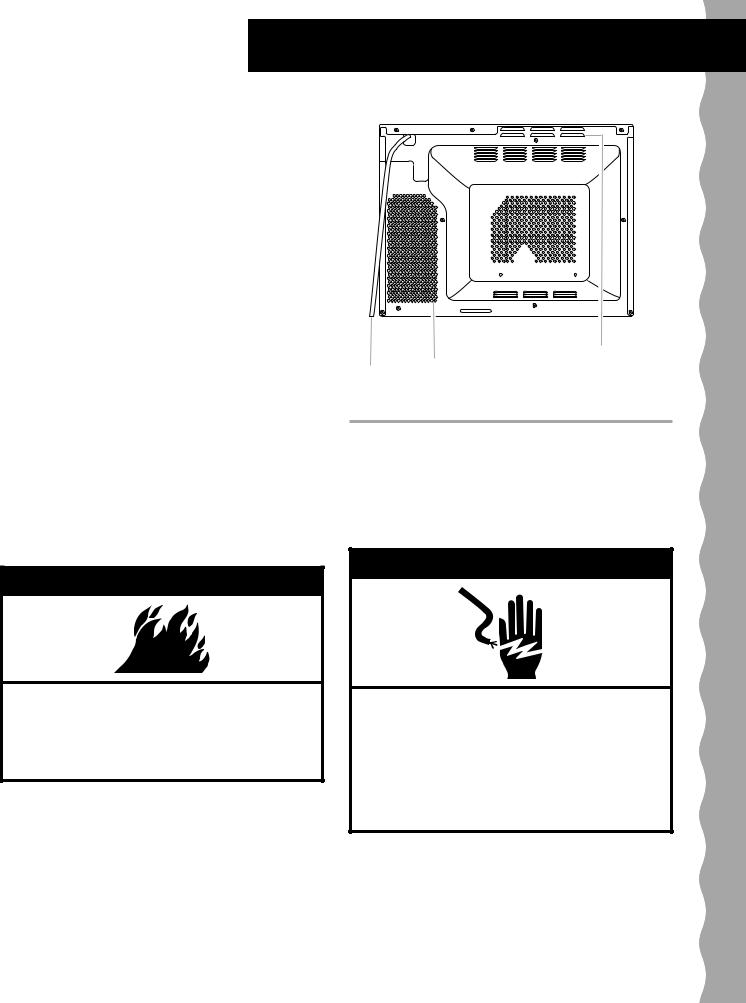
Installation Instructions
Before you begin operating the oven, carefully read the following instructions.
1.Empty the microwave oven. Clean the inside with a soft, damp cloth. Check for damage such as a door that isn’t lined up correctly, damage around the door, or dents inside the oven or on the exterior. If there is any damage, do not operate the oven until a designated service technician has checked it and made any needed repairs.
2.Put the oven on a cart, counter, table, or shelf that is strong enough to hold the oven and the food and utensils you put in it. (The control side of the unit is the heavy side. Use care when handling the oven.) The weight of the oven is about 55 lbs
(25 kg). The microwave oven should be at a temperature above 50°F (10°C) for proper operation.
NOTE: You can build your microwave oven into a wall or cabinet by using one of the trim kits listed in the “Built-in kits” section.
NOTE: Do not block the exhaust vents or air intake openings. Allow a few inches of space at the back of the oven where the exhaust vents are located. Blocking the exhaust vents could cause damage to the oven and poor cooking results. Make sure the microwave oven legs are in place to ensure proper airflow. If vents are blocked, a sensitive thermal safety device may automatically turn the oven off. The oven should work properly once it has cooled.
wWARNING
Fire Hazard
Do not install the oven next to or over a heat source without a UL approved trim kit.
Doing so can result in death, fire, or electrical shock.
|
|
Air intake |
Exhaust vent |
|
|
||
Power |
|
opening |
(in rear) |
supply cord |
|
(in rear) |
|
ELECTRICAL REQUIREMENTS
Observe all governing codes and ordinances. A 120 Volt, 60 Hz, AC only, 15or 20-amp fused electrical supply is required. (A time-delay fuse is recommended.) It is recommended that a separate circuit serving only this appliance be provided.
wWARNING
Electrical Shock Hazard
Plug into a grounded 3 prong outlet.
Do not remove ground prong.
Do not use an adapter.
Do not use an extension cord.
Failure to follow these instructions can result in death, fire, or electrical shock.
5
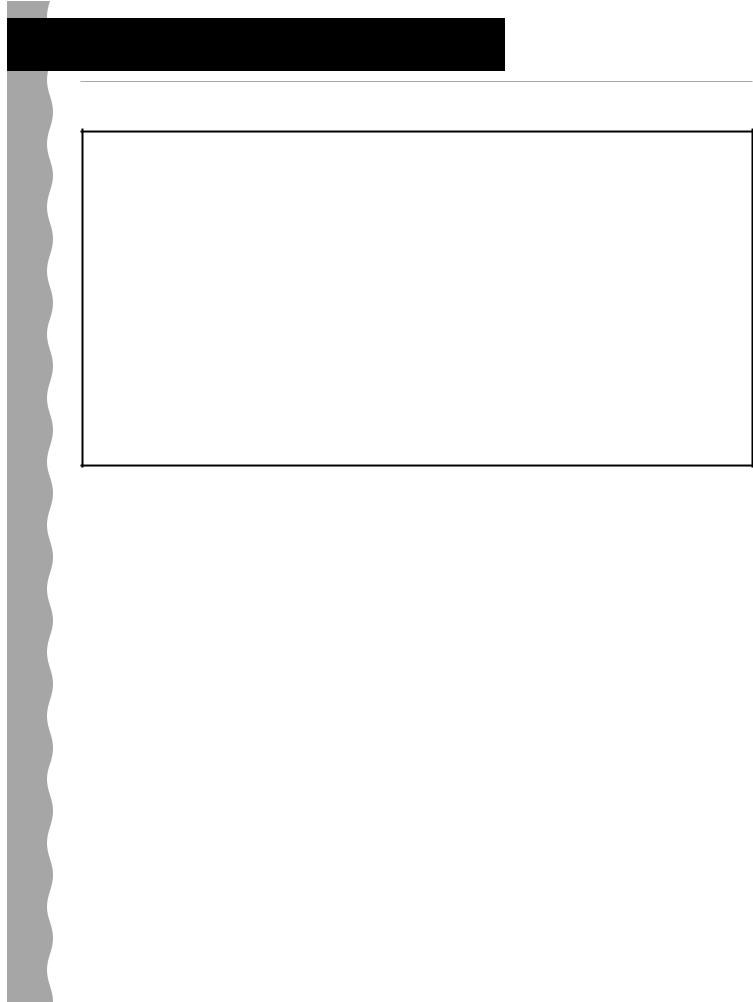
Installation Instructions
Electrical requirements
GROUNDING INSTRUCTIONS
•For all cord connected appliances:
The microwave oven must be grounded. In the event of an electrical short circuit, grounding reduces the risk of electric shock by providing an escape wire for the electric current. The microwave oven is equipped with a cord having a grounding wire with a grounding plug. The plug must be plugged into an outlet that is properly installed and grounded.
WARNING: Improper use of the grounding plug can result in a risk of electric shock.
Consult a qualified electrician or serviceman if the grounding instructions are not completely understood, or if doubt exists as to whether the microwave oven is properly grounded.
Do not use an extension cord. If the power supply cord is too short, have a qualified electrician or serviceman install an outlet near the microwave oven.
•For a permanently connected appliance:
The microwave oven must be connected to a grounded, metallic, permanent wiring system, or an equipment grounding conductor should be run with the circuit conductors and connected to the equipment grounding terminal or lead on the microwave oven.
SAVE THESE INSTRUCTIONS
6
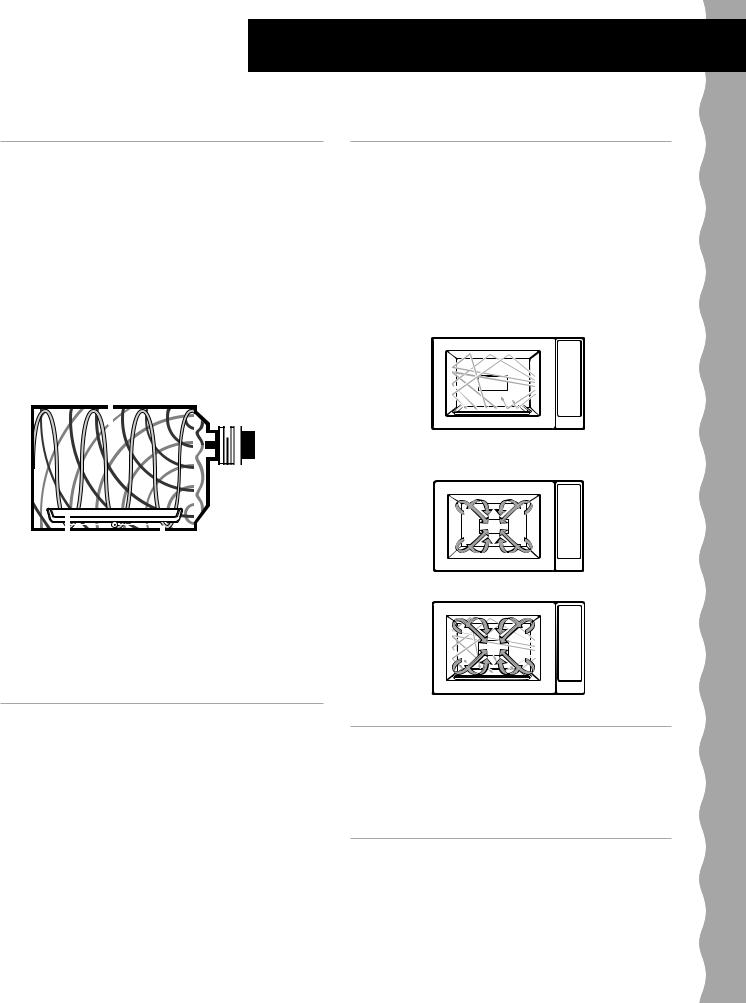
Getting to Know Your Microwave Oven
This section discusses the concepts behind microwave cooking. It also shows you the basics you need to know to operate your microwave oven. Please read this information before you use your oven.
How your microwave oven works
Microwave energy is not hot. It causes food to make its own heat, and it’s this heat that cooks the food.
Microwaves are like TV waves, radio waves, or light waves. You cannot see them, but you can see what they do.
A magnetron in the microwave oven produces microwaves. The microwaves move into the oven where they contact food as it turns on the turntable.
Your oven has a multiple microwave distribution system. Microwave energy is released from two locations, giving you better, more even cooking.
|
|
|
Oven cavity |
|
|
|
|
Magnetron |
|||||||||||
|
|
|
|
|
|
|
|
|
|
|
|
|
|
|
|
|
|
|
|
|
|
|
|
|
|
|
|
|
|
|
|
|
|
|
|
|
|
|
|
|
|
|
|
|
|
|
|
|
|
|
|
|
|
|
|
|
|
|
|
|
|
|
|
|
|
|
|
|
|
|
|
|
|
|
|
|
|
|
|
|
|
|
|
|
|
|
|
|
|
|
|
|
|
|
|
|
|
|
|
|
|
|
|
|
|
|
|
|
|
|
|
|
|
|
|
|
|
|
|
|
|
|
|
|
|
|
|
|
|
|
|
|
|
|
|
|
|
|
|
|
|
|
|
|
|
|
|
|
|
|
|
|
|
|
|
|
|
|
|
|
|
|
|
|
|
|
|
|
|
|
|
|
|
|
|
|
|
|
|
|
|
|
|
|
|
|
|
|
|
|
|
|
|
|
|
|
|
|
|
How combination cooking works
Sometimes combination microwave-convection cooking is suggested to get the proper cooking results. It shortens the cooking time for foods that normally need a long time to cook. This cooking process also leaves meats juicy on the inside and crispy on the outside. In combination cooking, the convection heat and microwave energy alternate automatically. Your oven has a setting that makes it easy to cook with both convection heat and microwave energy automatically.
Microwave
+
Glass turntable |
Metal floor |
The glass turntable of your microwave oven lets microwaves pass through. Then they bounce off a metal floor, back through the glass turntable, and are absorbed by the food.
Microwaves pass through most glass, paper, and plastics without heating them so food absorbs the energy. Microwaves bounce off metal containers so food does not absorb the energy.
How convection cooking works
Convection cooking circulates hot air through the oven cavity with a fan. The constantly moving air surrounds the food to heat the outer portion quickly. Your oven uses convection cooking whenever you use the Auto Convection, Custom Convection or Combination cooking programs.
DO NOT USE THE OVEN WITHOUT THE TURNTABLE IN PLACE.
Convection
=
Combination microwave/convection
How broiling works
Broiling is achieved by two radiant heating elements at the top of the microwave oven. The hot air is circulated through the oven cavity with a fan. The food on the broiling rack is cooked by radiant heat and circulating hot air.
Microwave cooking tips
Amount of food
•If you increase or decrease the amount of food you prepare, the time it takes to cook that food will also change. For example, if you double a recipe, add a little more than half the original cooking time. Check for doneness and, if necessary, add more time in small
increments. |
7 |

Getting to Know Your Microwave Oven
Starting temperature of food
•The lower the temperature of the food being put into the microwave oven, the longer it takes to cook. Food at room temperature will be reheated more quickly than food at refrigerator temperature.
•The length of the standing time depends on how much food you are cooking and how dense it is. Sometimes it can be as short as the time it takes you to remove the food from the oven and take it to the serving table. However, with larger, denser food, the standing time may be as long as 10 minutes.
Composition of food
•Food with a lot of fat and sugar will be heated faster than food containing a lot of water. Fat and sugar will also reach a higher temperature than water in the cooking process.
•The more dense the food, the longer it takes to heat. “Very dense” food like meat takes longer to reheat than lighter, more porous food like sponge cakes.
Size and shape
•Smaller pieces of food will cook faster than larger pieces. Also, same-shaped pieces cook more evenly than different-shaped pieces.
•With foods that have different thicknesses, the thinner parts will cook faster than the thicker parts. Place the thinner parts of chicken wings and legs in the center of the dish.
Stirring, turning foods
•Stirring and turning foods spreads heat quickly to the center of the dish and avoids overcooking at the outer edges of the food.
Covering food
Cover food to:
•Reduce splattering
•Shorten cooking times
•Keep food moist
You can use any covering that lets microwaves pass through. See “Getting to Know Your Microwave Oven” for materials that microwaves will pass through. If you are using the Sensor function, be sure to vent.
Releasing pressure in foods
•Several foods (for example: baked potatoes, sausages, egg yolks, and some fruits) are tightly covered by a skin or membrane. Steam can build up under the membrane during cooking, causing the food to burst. To relieve the pressure and to prevent bursting, pierce these foods before cooking with a fork, cocktail pick, or toothpick.
Using standing time
•Always allow food to stand after cooking. Standing time after defrosting and cooking allows the temperature to evenly spread throughout the food,
8 |
improving the cooking results. |
|
Arranging food
For best results, place food evenly on the plate. You can do this in several ways:
•If you are cooking several items of the same food, such as baked potatoes, place them in a ring pattern for uniform cooking.
•When cooking foods of uneven shapes or thickness, such as chicken breasts, place the smaller or thinner area of the food towards the center of the dish where it will be heated last.
•Layer thin slices of meat on top of each other.
•When you cook or reheat whole fish, score the skin – this prevents cracking.
•Do not let food or a container touch the top or sides of the oven. This will prevent possible arcing.
Using aluminum foil
Metal containers should not be used in a microwave oven. There are, however, some exceptions. If you have purchased food which is prepackaged in an aluminum foil container, refer to the instructions on the package. When using aluminum foil containers, cooking times may be longer because microwaves will only penetrate the top of the food. (See “Oven Utensils Guide”.)
If you use aluminum containers without package instructions, follow these guidelines:
•Place the container in a glass bowl and add some water so that it covers the bottom of the container, not more than 1⁄4 in. (.64 cm) high. This ensures even heating of the container bottom.
•Always remove the lid to avoid damage to the oven.
•Use only undamaged containers.
•Do not use containers taller than 3⁄4 in. (1.9 cm).
•Container must be at least half filled.
•To avoid arcing, there must be a minimum 1⁄4 in. (.64 cm) between the aluminum container and the walls of the oven and also between two aluminum containers.
•Always place the container on the turntable.
•Reheating food in aluminum foil containers usually takes up to double the time compared to reheating in plastic, glass, china, or paper containers.
The time when food is ready will vary depending upon the type of container you use.
•Let food stand for 2 to 3 minutes after heating so that heat is spread evenly throughout container.

Getting to Know Your Microwave Oven
Cooking you should not do in your microwave oven
•Do not do canning of foods in the oven. Closed glass jars may explode, resulting in damage to the oven.
•Do not use the microwave oven to sterilize objects (baby bottles, etc.). It is difficult to keep the oven at the high temperature needed for sterilization.
Radio interference
Using your microwave oven may cause interference to your radio, TV, or similar equipment. When there is interference, you can reduce it or remove it by:
•Cleaning the door and sealing surfaces of the oven.
•Adjusting the receiving antenna of the radio or television.
•Moving the receiver away from the microwave oven.
•Plugging the microwave oven into a different outlet so that the microwave oven and receiver are on different branch circuits.
For the best cooking results
•Always cook food for the shortest cooking time recommended. Check to see how the food is cooking. If needed, touch EASY START pad while the oven is operating or after the cooking cycle is over (see the “Using EASY START” section).
•Stir, turn over, or rearrange the food being cooked about halfway through the cooking time for all recipes. This will help make sure the food is evenly cooked.
•If you do not have a cover for a dish, use wax paper, or microwave-approved paper towels or plastic wrap. Remember to turn back a corner of the plastic wrap to vent steam during cooking.
Testing your microwave oven
To test the oven, put 1 cup (250 mL) of cold water in a glass container in the oven. Close the door. Make sure it latches. Cook at 100% power for 2 minutes.
When the time is up, the water should be heated.
Oven utensils guide
You can use a variety of utensils and materials in your microwave-convection oven. To prevent damage to utensils and your oven, choose appropriate utensils and materials for each cooking method. The list below is a general guide to help you select the correct utensils and materials.
YES: Utensils to use
NO: Utensils to avoid
|
|
|
|
BROIL/ |
|
|
MICRO- |
COMBINA- |
CONVEC- |
|
|
WAVE |
TION |
TION |
MATERIAL |
UTENSILS |
COOKING |
COOKING |
COOKING |
Ceramic |
Ceramic |
YES |
YES |
YES |
& Glass |
Ovenproof, |
YES |
YES |
YES |
|
Heat- |
|
|
|
|
Tempered, |
|
|
|
|
Microwave- |
|
|
|
|
Safe |
|
|
|
|
Glassware |
|
|
|
|
Glassware |
NO |
NO |
YES |
|
with Metal |
|
|
|
|
Decoration |
|
|
|
|
Lead Glass |
NO |
NO |
YES |
China |
Without |
YES |
YES |
YES |
|
Metal |
|
|
|
|
Decoration |
|
|
|
|
(Ovenproof |
|
|
|
|
and Heat- |
|
|
|
|
Tempered) |
|
|
|
Pottery |
Ovenproof |
YES |
YES |
YES |
|
pottery |
|
|
|
Plastic |
Ovenproof |
YES |
YES |
YES |
|
Microwave- |
YES |
NO |
NO |
|
safe plas- |
|
|
|
|
ticware |
|
|
|
Metal |
Bake/Roast |
NO |
NO |
YES |
|
Rack |
|
|
|
|
Metal |
NO |
NO |
YES |
|
Baking Pan |
|
|
|
Aluminum |
|
* |
* |
YES |
Foil |
|
|
|
|
Paper |
Cups, |
YES |
NO |
NO |
|
Plates, |
|
|
|
|
Towels |
|
|
|
Straw, |
|
YES |
NO |
NO |
Wicker, |
|
|
|
|
Wood |
|
|
|
|
Wax |
|
YES |
NO |
NO |
Paper |
|
|
|
|
Plastic |
|
YES |
NO |
NO |
Wrap |
|
|
|
|
|
|
|
|
|
*Refer to “Microwave cooking tips” and “Questions and Answers” for proper use.
9
